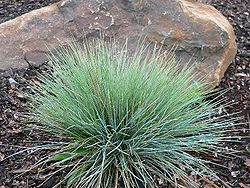Difference between revisions of "Festuca roemeri"
(→Uses) |
|||
| Line 1: | Line 1: | ||
'''Common name:''' Roemer’s fescue, Bluebunch fescue, Blue bunchgrass, Bunchgrass fescue, Idaho fescue | '''Common name:''' Roemer’s fescue, Bluebunch fescue, Blue bunchgrass, Bunchgrass fescue, Idaho fescue | ||
| − | + | [[File:Festucaroemerilvs.jpg|thumb|right|250px]] | |
'''Abbreviation Code (Codon):''' FERO | '''Abbreviation Code (Codon):''' FERO | ||
==Taxonomy== | ==Taxonomy== | ||
| Line 28: | Line 28: | ||
==Propagation== | ==Propagation== | ||
| − | |||
==References== | ==References== | ||
| + | ==Photo Gallery== | ||
[[File:Festucaroemerilvs.jpg|250px]] | [[File:Festucaroemerilvs.jpg|250px]] | ||
Revision as of 11:55, 21 May 2012
Common name: Roemer’s fescue, Bluebunch fescue, Blue bunchgrass, Bunchgrass fescue, Idaho fescue
Abbreviation Code (Codon): FERO
Contents
Taxonomy
Description
Roemer’s fescue is a native cool season perennial bunchgrass with variable longevity and mostly basal foliage. It is short, fine textured, and densely tufted, and has stiff culms that grow 35-100 cm tall. The panicle (seed head) is open and 5-20 cm long. Leaves are often glaucous (covered with a whitish waxy coating) and color varies throughout a wide spectrum of greens and blues. Stem color ranges from light green to dark purple or red.
Bloom Period
Distribution
Habitat
Rocky slopes & dry openings in woods below 5000 ft. Deep, fertile to thin, rocky soils.
It prefers moderately acid to slightly alkaline, fine to medium textured mineral soils. Medium water use – While drought tolerant with extensive roots, it is found on somewhat more mesic (moist) sites such as the edges of grassy balds. As an upland grass it requires good soil drainage and does not tolerate winter soil saturation or flooding.
The species generally grows in full sun but will tolerate partial shade near forest edges and oaks.
Roemer’s fescue is a mid to late succession species in its natural habitat.
Uses
Roemer’s fescue is an important native grass for restoration of upland prairie and oak savanna within its natural range of western Oregon, western Washington, and northwest California. Typically found on steep, shallow, or highly mineral soils, it may also be useful for revegetation and erosion control where a slower establishing, fine textured native grass is desired. Although Roemer’s fescue does not compete well with introduced grasses.
Larval host to Sonora skipper. Forage value and palatability for wildlife and livestock are unknown, but may be similar to Idaho fescue (F. idahoensis). Possible uses are low maintenance lawns or as a cover crop in vineyards and young orchards, although further evaluation is needed. Some populations and specimens have ornamental value, including those with fine textured, purple and red tinged stems or bluish foliage.
As a range grass, Idaho fescue is rated as fair to good forage.

